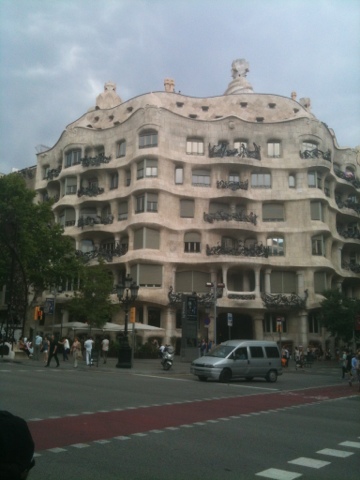He showed me his architecture office and some of his work. Francesc and Merce live and work in the same building. We watched one of his two sons play hocky on skates. We walked over to the traditional market to shop for pasta and vegetables, and had a nice lunch at their house.
Barcelona was in the cup of Europe, their Super Bowl, so the team colors are everywhere. We watched the game on TV. Barcelona beat Turin. Every time the team scored you could hear the excitement coming in the window. The streets were celebrating, again like the Super Bowl.
It is hot here, and they don't have air conditioning. It cools down some at night, but not as much as Colorado.
We slept in, after staying up late for the game. After breakfast we drove a hour or so north to Calella de Palafrugell, where the family has a condo. This is near the Costa Brava.
Monday was a normal work and school day for them, so I went on a walk through the old city and newer areas.
Of course, Las Ramblas is well known to tourists. My friends complain about the tourists, and I can see why. Not that they are bad, but they seem to be everywhere. In many places I think that they outnumber the locals.
And how could I produce a blog post on Barcelona without mentioning Gaudi? This is his apartment building.
I did visit the contemporary art museum. There were some interesting pieces, including a collection of models and samples from one sculptor. There were also two interesting videos from Arab artists, both with political aspects.
Tuesday Morning, I said bye to Francesc and Merce. Francesc took me to Plaza Cataluna, where I caught the bus to the airport. I arrived in plenty of time, and the United flight was on time.
However congestion at Newark meant that we took the long way, as you can see in the map.
The Newark airport has pay phones everywhere, but with stickers on them saying that they no longer offer that service. They claim to have 30 minutes of free Wifi; however, I found the hoops that I had to jump through for free Wifi impossible to get through, probably by design. I had a long layover in Newark. I did have a nice chat in the food court with a Boeing manufacturing engineer who knew southern France and northern Spain very well.
The flight was overbooked, and I volunteered to be bumped, but I ultimately got on. I was very tired by the time I got to Denver, but I took the bus to Boulder and walked home. The cats were glad to see me.
It will take some time to digest the trip, I think.















